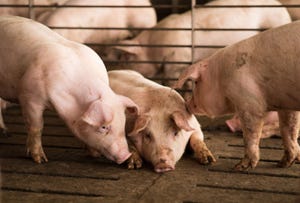G. parasuis sequencing uncovers invasive strains in U.S. swine production systems
Discovery highlights the extensive diversity of Glaesserella parasuis strains present in North American pig populations.
April 2, 2024

By Robert Mugabi and Maria J. Clavijo, College of Veterinary Medicine, Iowa State University
Glaesserella parasuis is a Gram-negative bacterium known to be the causative agent of Glässer’s disease in pigs. This disease manifests with lesions such as arthritis, meningitis, endocarditis and polyserositis, typically affecting pigs between 4 to 8 weeks of age. Clinical signs are abdominal breathing or coughing, lameness, paddling and septicemia with acute death (Vahle et al., 1995).
While the pathogen was initially described in 1910 (Aragon et al., 2019), G. parasuis continues to pose significant challenges to the health and productivity of swine production systems today. Remarkably, over the past decade, the incidence of G. parasuis-related disease has increased in swine cases received at the Iowa State University Veterinary Diagnostic Laboratory (ISU-VDL) (Silva et al., 2023). This trend underscores the ongoing importance of surveillance, research and proactive management strategies to address the evolving threat posed by G. parasuis to swine health and industry sustainability.
With the declining costs of sequencing and advancements in bioinformatics, whole genome sequencing has become increasingly viable for diagnostic applications and pathogen typing. Veterinary Diagnostic Laboratories, such as ISU-VDL, now routinely offer WGS services to clients, reflecting the growing adoption of this advanced technology. WGS provides unparalleled discriminatory power between isolates by facilitating the extraction of crucial information regarding phylogeny, sequence type, putative virulence factors, and antimicrobial resistance genes.
The objective of our recently published research was to characterize G. parasuis strains isolated from disease-associated cases using WGS. Through this approach, we aimed to shed light on the genetic diversity and virulence profiles of G. parasuis strains, ultimately contributing to more effective disease management strategies in pig populations.
A total of 218 G. parasuis isolates were collected from porcine clinical cases submitted to the ISU VDL spanning from 2015 through 2022. The majority of strains were sourced from the USA (n=154), with additional isolates obtained from Canada (n=20), Chile (n=9), Denmark (n=4), Peru (n=6) and Mexico (n=25). Each isolate was accompanied by metadata detailing the year of isolation, tissue type, flow and farm name, as well as the age of the affected pig. Notably, strains from the USA originated from at least 16 different states. The isolates were from at least 147 farms and 65 flows. These isolates were whole-genome sequenced at ISU-VDL, where their AMR, virulence genes, serotypes and sequence types were derived from WGS data.
Our analysis revealed a total of 11 G. parasuis serotypes (Figure 1). The most frequently detected serotypes were 7 (32.6%, 71/218), 13 (16.1%, 35/218), 2 (14.7%, 32/218), 4 (14.2%, 31/218) and 5/12 (7.3%, 16/218), highlighting the prevalence of these serotypes within the sampled population. Serotype 7 strains have historically been regarded as avirulent; however, there is growing evidence suggesting their involvement in disease. The results obtained in this study further corroborate this notion.
Recent research, such as that conducted by Macedo et al. in 2021, has highlighted the frequent identification of serotype 7 strains isolated from clinical cases across diverse regions, including the USA, Canada, Europe, China and Vietnam. The widespread distribution of serotype 7 may potentially be attributed to pig trade between countries or companies, facilitating the spread of this pathogen across different regions. These findings underscore the critical importance of ongoing surveillance and control efforts to address the emergence and spread of clinically significant serotypes, such as serotype 7, within global swine populations. Vigilant monitoring and coordinated management strategies are essential for mitigating the impact of emerging pathogens and safeguarding swine health worldwide.
The multilocus sequence typing analysis uncovered a total of 72 sequence types, among which 66 were identified as novel STs. This significant discovery highlights the extensive diversity of G. parasuis strains present in North American pig populations. It underscores the necessity of employing comprehensive molecular typing approaches to gain insights into strain diversity and epidemiology accurately. Such detailed analyses are crucial for understanding the dynamics of pathogen transmission and for implementing effective disease control measures within swine populations.
Despite the high ST diversity observed, one of the key findings in this project was the identification of an emerging novel serotype 7 ST454 strain occurring at a notably high frequency. This discovery highlights the significance of this particular strain within the population. In fact, almost 20% of the isolates were identified as ST454, distributed across at least 24 farms and 14 flows.
Implementing targeted control and elimination strategies, such as incorporating ST454 into autogenous vaccine or considering depopulation measures for herds carrying such ST, could potentially alleviate the disease burden caused by G. parasuis for numerous farms. These proactive measures are crucial for preventing further spread and reducing the impact of G. parasuis infections on swine health and production.
The study also showed that within production systems, multiple farms harbored at least two sequence types, aligning with previous knowledge that multiple G. parasuis strains can coexist within a single production system (Cerdà-Cuéllar et al., 2010). This diversity within a system underscores the potential contribution of multiple strains to disease outbreaks.
Consequently, effective disease control strategies should prioritize the characterization of clinically relevant strains within each flow. This approach enables the identification of suitable vaccine candidates for autogenous vaccine production, evaluation of the potential efficacy of commercially available vaccines, and improvement of replacement animal sourcing and pig flow management (Mugabi et al., 2023).
References
Aragon V, Segales J, Tucker AW. Glässer’s disease. In: Zimmerman JJ, Karriker LA, Ramirez A, Schwartz K, Stevenson GW, Zhang J (eds) Diseases of Swine. Ames, Wiley-Blackwell; 2019. p. 844-852
Vahle JL, Haynes JS, Andrews JJ. Experimental reproduction of Haemophilus parasuis infection in swine: clinical, bacteriologic, and morphologic findings. J Vet Diagn Invest. 1995; 7(4):476-80. Doi: 10.1177/104063879500700409
Brockmeier SL, Register KB, Kuehn JS, Nicholson TL, Loving CL, Bayles DO, Shore SM, Phillips GJ. Virulence and draft genome sequence overview of multiple strains of the swine pathogen Haemophilus parasuis. PloS one. 2014; 9(8): e103787. Doi:
Silva, Ana Paula Serafini Poeta et al. “Detection and disease diagnosis trends (2017-2022) for Streptococcus suis, Glaesserella parasuis, Mycoplasma hyorhinis, Actinobacillus suis and Mycoplasma hyosynoviae at Iowa State University Veterinary Diagnostic Laboratory.” BMC veterinary research vol. 19,1 268. 12 Dec. 2023, doi:10.1186/s12917-023-03807-w
Cerdà-Cuéllar M, Naranjo, JF, Verge A, Nofrarias M, Cortey M, Olvera A, Segalés, Aragon V. Sow vaccination modulates the colonization of piglets by Haemophilus parasuis. Vet microbiol. 2010; 145(3-4), 315-320.
Mugabi, Robert et al. “Molecular characterization of Glaesserella parasuis strains circulating in North American swine production systems.” BMC veterinary research vol. 19,1 135. 28 Aug. 2023, doi:10.1186/s12917-023-03698-x
You May Also Like



